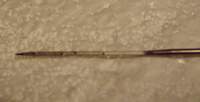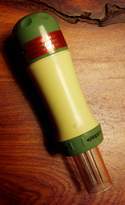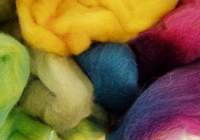Needle Felting Equipment
What You Need To Get Started
Needle felting equipment won't break the bank. You really don't need
to spend much to start enjoying needle felting. I'll tell you what you'll need and what I prefer to use.
Needles

First and foremost you need the needles. Wouldn't be needle felting
without them, would it? Now, there are 2 kinds of needle felting needles - triangular and star shaped shafts. Both types have barbs on the inch at the bottom. These barbs are what tangle and 'felt' the fibers as you prod or poke the fibers.
 The triangle shaped needles usually come in 3 sizes (the smaller the number the thicker the needle): 36 is thicker, 38
is the average multi-purpose size and 40 is the finer size. They can cost as little as $1 per needle, so that's no great fee for the
absolute "must have" of needle felting equipment.
The triangle shaped needles usually come in 3 sizes (the smaller the number the thicker the needle): 36 is thicker, 38
is the average multi-purpose size and 40 is the finer size. They can cost as little as $1 per needle, so that's no great fee for the
absolute "must have" of needle felting equipment.
The star shaped needle has the barbs on all 4 sides and is best for more detailed work. The individual needles are perfect for adding fine
lines or indentations to your work.
Needle Felting Tool

You can also find needle felting tools - they generally have 3-6 needles
grouped together. These are especially good for applique. If you
have an pre-felted piece or some wool felt you want to attach
to a finished project quickly, you can use a needle felting tool.
Foam
Another essential piece of needle felting equipment is a surface you can poke into without fear of damaging the table or your leg underneath, depending where you like to work.
I have tried upholstery foam, which tends to be a little too soft. You can find higher density foam too, but when you poke right through
all the fibers it ends up very fuzzy on the underside and you have to carefully peel your work off it regularly - not fun.
You can also buy brush style bases. I haven't tried them, but I hear they're not ideal, especially if you're working on a large project.
I prefer to use just a high density polystyrene foam like the kind used in the packing of computer products. It's FREE and it does the job just
great, as your project won't stick to it. You will still need to lift it off every so often, but I say it's much easier & way cheaper
than anything else. Just make sure that it's a totally flat surface with no holes or you may not be satisfied with your results.
Fiber

Some more needle felting equipment you're going to need is fiber. The best is corriedale as it's a little thicker and very springy (usually cheaper than merino), but I've also used merino. Merino takes
a little more work, but you can get some very fine details by using
only a few hairs.
You can also use heat bondable fibers which are generally shiny and
iridescent. These can be felted by combining or layering them with other wool
fibers.
Yarn
Yes, you can also needle felt with yarns. The best ones to use are
natural and loosely spun. You can use hairy or fancy yarns too for
different effects, but generally man-made yarns aren't going to 'stick' as well
as wool. If your wool shrinks and your man-made fibers don't you'll end up with a strange shaped piece, so I'd try & stick with similar fibers in the same project.
Fabric base
You can use wool felt or a % wool felt - it doesn't have to be 100%
to work well. You can also work directly onto a felted crochet or knitted
base. As long as it is fully felted and there are no gaps or spaces
in the fabric.
You can use your needle felting equipment directly onto firmer polar fleece, a felted sweater
or purse and even a thicker sweatshirt, jeans or a denim jacket. I've yet to try that, so
I'll keep you posted when I have some pictures and more information.
You can needle felt onto finer fabrics, but they can pucker and pull threads which doesn't look so good.
So, have I whetted your appetite to get hold of some needle felting equipment and try it out for yourself - are you ready to get started? On your marks...get set...GO FOR IT!
Have your tried felting with your washing machine?
Check out this info on Felted Crochet
Return to homepage from Needle Felting Equipment